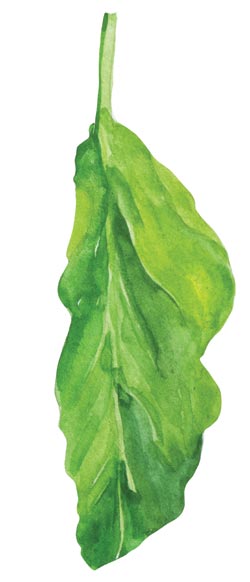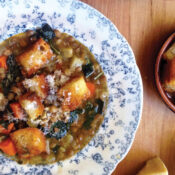
Alan Muskat raises a mason jar into the air. “I’ve made you birch tea,” he says. Inside the glass is a faintly golden liquid. Also, a generous number of sticks and twigs, the kind that scream “not edible!” at least to a city girl like me. Muskat pours the beverage into small cups so we can taste something wild. With his slight build, soft voice, and curly hair, he reminds me of a young Joel Grey. He’s grinning. Not for the first time that day, I wonder what I’ve gotten myself into.
It took a drive on a twisty mountain road to reach this spot on Laughing Frog Lane in Walnut, North Carolina, about half an hour from Asheville. I’m here for a guided tour with Muskat, proprietor of Wild Food Adventures, which specializes in teaching the lost art of foraging. It’s late October, but there’s still plenty to find in this rolling landscape, Muskat assures the dozen of us on the tour.
We start by learning the four critical questions to ask about any foraged item: Can you eat it? When is it in season? Do you eat it raw or must it be cooked? Where did you find it? Avoid heavily traveled roads, Muskat cautions, because the plants may be contaminated from car emissions. That’s not a problem on this private land where Muskat has permission to forage.
In the next several hours, we encounter wild foods at every turn. Common chickweed, with its small, teardrop leaves, looks like half the stray plants in my neighborhood but tastes like zippy lettuce. We see dandelions (leaf, flower, and root are all edible) and wild daisies. Mullen, whose soft leaves make a fine tea or, in a pinch, a fine toilet paper. Onion grass. Sheep sorrel, with its citrusy tang and fun shape like fish crackers.
Muskat gathers us around a cluster of shrubs with small red fruits. I’m pleased I’m the first to recognize it as sumac, often part of the Middle Eastern spice mix called za’atar. We head toward a glen to hunt for mushrooms. Muskat examines our finds and tosses the inedible and unusable. Later, at the landowner’s home, he chops and slowly sautés what we foraged — hen-of-the-woods mushrooms with wild onion, burdock roots, and sumac powder — with butter, salt, and pepper. The flavor is dark, earthy, and herby all at once, with the richness of a juicy steak.
to be suspicious if our food doesn’t come packaged and sanitized in the grocery store.”
There are practical benefits to foraging, from saving a bit on food costs to helping the environment by eating plants that don’t require pesticides, fertilizers, or irrigation. But the fundamental reason to forage is the connection it helps us create with the natural world. Foraging is a back-to-basics way to immerse yourself in a beautiful setting, focus on the present moment, and deeply satisfy your soul.
When we learn about plants by foraging, we become more self-reliant, and nature becomes understandable, almost intimate. “As a forager, I’ve learned to sense and anticipate the subtle changes in the seasons, almost like a sixth sense,” says Lisa M. Rose, author of Midwest Foraging: 115 Wild and Flavorful Edibles from Burdock to Wild Peach. “On sunny February days that are cold but bright, I can actually hear the sap in the maple trees begin to run. And April rainstorms with warmer weather means it’s time to go mushroom hunting.” Such seasonal changes are easier to miss when we are busy with office jobs and other indoor pursuits. We forget the natural world is part of wherever we live.
Foraging can’t be rushed. It teaches you to linger, to pay attention, to see what’s really there. Those weeds in a nearby park may actually be wild grapes or spicebush berries once your knowledge builds and your perceptions change. The heightened awareness from a foraging adventure can extend to other parts of your life, from noticing the vivid colors on a city street when you travel, to truly hearing the layered harmonies in a great piece of music. It’s no wonder foraging can be akin to a spiritual practice for some people.
At the same time, foraging imparts a useful lesson about acceptance. You can set out to collect a specific edible, but there’s no guarantee you will find it. A tree with figs last September may have none this September. Conditions change quickly, which means a forager learns to be flexible and to appreciate the opportunities that arise. “It’s easy to find what you’re not looking for when you’re foraging,” Muskat says.

Wild-food experts like to point out that wild foods are healthier because they can contain substantially more phytonutrients, vitamins, and fiber than store-bought produce. Phytonutrients are part of a plant’s defense against disease and predators. When we eat phytonutrients, these compounds may help guard against cancer, heart disease, and other illnesses, according to studies in the Journal of the National Cancer Institute and elsewhere. But we’ve bred phytonutrients out of farmed foods in part because they frequently taste astringent or bitter, says Jo Robinson, an investigative journalist and author of Eating on the Wild Side: The Missing Link to Optimum Health. Just one example: Dandelion leaves have more calcium, vitamins A, E, and K, and antioxidants than spinach.
Some foragers take the healthy properties of wild plants a step further and forage for medicinal ingredients for making teas and other remedies. “Whenever a bee stings me, I immediately start looking for plantain,” says Sergei Boutenko, author of Wild Edibles: A Practical Guide to Foraging. “Plantain has soothing properties that help reduce swelling and relieve pain. I chew up a few leaves and apply the green mush to the affected area for instant relief.”
Reishi mushrooms have been a hallmark of traditional Chinese medicine for thousands of years and are believed to boost the immune system, among other uses. “They’re really good if you feel you have a cold coming on,” says Ava Chin, former Urban Forager columnist for The New York Times and author of Eating Wildly: Foraging for Life, Love and the Perfect Meal, who boils them to create a (bitter, it must be said) tea. And some studies demonstrate the value of feverfew for preventing and treating migraines.
Foraging isn’t new, of course. While farming began anywhere from 12,000 to 23,000 years ago, foraging has been a given as long as people have inhabited the planet. That includes past generations of Americans, who were, by necessity, well-informed about wild plants. Foraging became less necessary during the industrial revolution, and practically disappeared by the 1950s, as packaged foods took hold. It took writer Euell Gibbons to reintroduce Americans to the notion that the wild held good things to eat with the publication in 1962 of his bestseller Stalking the Wild Asparagus. [See “Would You Like Weeds with That?”]
Though Americans cook with far more ingredients now than 50 years ago, some still regard uncultivated foods with unease. “As Americans, we tend to be suspicious if our food doesn’t come packaged and sanitized in the grocery store,” says Chin. But that attitude is changing. Restaurant chefs and craft breweries are using foraged ingredients to add a chic and unexpected element to their offerings. Hotels and inns are starting to offer foraging adventures among their activities. There are foraging and wild foods festivals from Big Sur, California, to Reidsville, North Carolina. “We mean to teach people about what’s edible in their local landscape, and in doing so, help them look at the area where they live in a different way,” says Iso Rabins, founder of forageSF in San Francisco.
My foraging experience changed my outlook, too. Out in the woods, foraging with friends, the world is a safe and abundant place. And all the references I’ve heard over the years to nature’s gifts and bounty? I understand them anew when I see the evidence on wild soil.
Interested in learning more? Find how-to’s, classes, and tours across the U.S. at saturdayeveningpost.com/foraging.
Become a Saturday Evening Post member and enjoy unlimited access. Subscribe now



